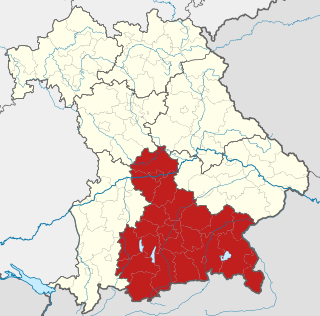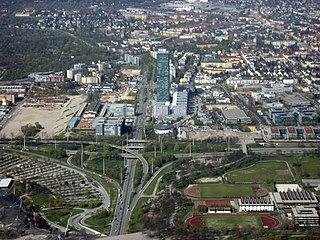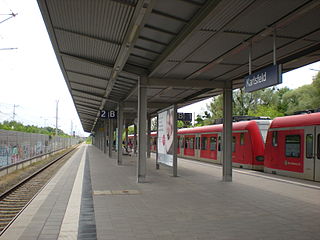
Upper Bavaria is one of the seven administrative districts of Bavaria, Germany.

Scheyern Abbey, formerly also Scheyern Priory, is a house of the Benedictine Order in Scheyern in Bavaria.

Allach porcelain a.k.a. Porzellan Manufaktur Allach was produced in Germany between 1935 and 1945. After its first year of operation, the enterprise was run by the SS with forced labor provided by the Dachau concentration camp. The emphasis was on decorative ceramics —objets d'art for the Nazi regime. The company logo included stylized SS runes. Sometimes in place of the company name, the pottery markings mentioned the SS: "DES - WIRTSCHAFTS - VERWALTUNGSHAUPTAMTES". Ceramic artist, master potter and author Edmund de Waal describes the double-lightning insignia of the SS that marked the Allach products as a clever transposition of Germany's famed Meissen porcelain mark of two crossed swords.

Altstadt and Lehel are districts of the German city of Munich. Together they form the first borough of the city: Altstadt-Lehel.

Aubing-Lochhausen-Langwied is the 22nd borough of the German city of Munich. The districts Aubing, Lochhausen and Langwied were incorporated together in 1942, thus forming the largest borough of the city at 3,400 hectares, yet having the lowest density of population with 37,352 residents as of 2002. This large borough still accommodates many vast agricultural and forest areas that together with the Aubinger Lohe and the Langwieder lake district, fulfill the balance of nature in the area and offer recreational facilities to all of western Munich.

Au-Haidhausen is the 5th borough of the German city of Munich, Bavaria. It is formed by the Au and Haidhausen districts.

Au is a district in the south eastern plain tract of the German city of Munich in Bavaria. Au extends from the Deutsches Museum in the north and along the Isar up to Wittelsbacherbrücke in the south.

Bundesautobahn 99 is an autobahn in southern Germany. It is the Munich outer ring road.

Thalkirchen-Obersendling-Forstenried-Fürstenried-Solln is the 19th borough of Munich, Germany, comprising the extreme southern part of the city on the west bank of the river Isar. After the administrative reform, the boroughs Thalkirchen-Obersendling-Forstenried and Solln were incorporated, thus forming the new borough. It comprises 17.7631 square kilometres and has a population of 96,714 residents.

Munich-Allach concentration camp was a forced labour camp established by the Nazi Schutzstaffel (SS) in Allach-Untermenzing, a suburb of Munich in southern Germany, in 1943. It provided slave labour for nearby factories of BMW, Dyckerhoff, Sager & Woerner, Kirsch Sägemühle, Pumpel Lochhausen and Organisation Todt with up to 17,000 prisoners in 1945. More than 1,800 of them came to death. It was the largest sub-camp of the Dachau concentration camp system. Another smaller subcamp Allach porcelain a.k.a. Porzellan Manufaktur Allach with about 40 prisoners produced porcelain artworks.

The Langwieder lake district is composed of three lakes west of Munich in Bavaria, Germany. It opened in the year 2000 as a recreational area enclosing the Langwieder See, the Lußsee, and the Birkensee. The entire site spans 120 hectares ; 40 of which are the lakes and 80 are land; 27 hectares of which are lawns for sunbathing.

Moosach is the 10th northwestern district of Munich, Bavaria, Germany. It is sectioned in the urban districts Hartmannshofen, Pressestadt and Borstei.

Feldmoching-Hasenbergl is a borough in the northern part of the city of Munich in Bavaria, Germany. It contains the S-Bahn railway station of München-Feldmoching.

The Munich Fire Department is the firefighting authority of the City of Munich. The Munich fire department is divided into a professional department with approximately 1500 fire fighters staffing a total of 10 fire stations located strategically throughout the city to meet the legal aid period of 10 Minutes, and a volunteer fire department, whose approximately 1,050 members are organized in 22 companies. Each year, the Munich Fire Department responds to about 80,000 calls. The volunteers respond to about 3,500 calls annually. This makes the Munich Fire Department the third largest fire department as well as the largest municipal fire department in Germany.

Munich-Karlsfeld station is a railway station in the municipality of Karlsfeld, located in the district of Dachau in Upper Bavaria, Germany.

Munich-Allach station is a railway station in the Allach-Untermenzing borough of Munich, Germany.

Lochholz is a landscape conservation area in Munich. The area, in the district Allach-Untermenzing, covers 7,13 hectares and was declared a landscape conservation area in 1964. The oak and hornbeam forest is a remnant of the former Lohwaldgürtel north of Munich. Lochholz is part of the KulturGeschichtsPfad Allach-Untermenzing.

The Allacher Forest is a forest north of Munich, in the district of Allach-Untermenzing.

Munich West/Centre is an electoral constituency represented in the Bundestag. It elects one member via first-past-the-post voting. Under the current constituency numbering system, it is designated as constituency 220. It is located in southern Bavaria, comprising the western and central part of the city of Munich.




















